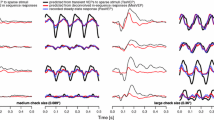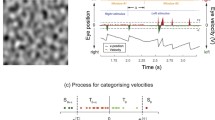Abstract
Accommodation power was measured with pattern visual evoked potentials in 12 normal subjects and three patients suffering from psychogenic visual disturbances and accommodation failure. Steady-state visual evoked cortical potentials recorded by increasing a minus-power lens in front of the eye in 1 diopter steps. The regression line was established from the visual evoked cortical potential amplitudes vs accommodation stimulus plot, and the objective accommodation power was determined by extrapolating the line to zero amplitude. The accommodation power measured by visual evoked cortical potentials was larger by approximately 2 diopters than that obtained subjectively by near-point rule in normal subjects. The subjective accommodation power was remarkably low for their age in each patient but the objective power was normal. These results suggest that the decrease of accommodation in these patients was caused by psychogenic mechanisms, and visual evoked cortical potential measurements of accommodation could provide helpful information for diagnosis.
Similar content being viewed by others
References
Miller NR. Walsh and Hoyt's clinical neuro-ophthalmology. Vol 2. Baltimore Md: Williams & Wilkens 4: 528–33.
Yamamoto S, Adachi-Usami E, Kuroda N. Accommodation power determined with transient pattern visual evoked cortical potentials in diabetes. Doc Ophthalmol 1989; 72: 31–7.
Woodhouse JM, Meades JS, Leat SJ, Saunders KJ. Reduced accommodation in children with Down syndrome. Invest Ophthalmol Vis Sci 1993; 34: 2382–7.
Ukai K, Ishikawa S. A quasistatic study on accommodation [in Japanese]. Acta Soc Ophthalmol Jpn 1987; 92: 494–7.
Toyonaga N, Adachi-Usami E. Accommodative response changes with age measured by pattern electroretinogram. Doc Ophthalmol 1993; 83: 131–8.
Duane A. Studies in monocular and binocular accommodation with their clinical application. Am J Ophthalmol 1922; 5: 865–77.
Millodot M, Newton I. VEP measurement of the amplitude of accommodation. Br J Ophthalmol 1981; 65: 294–8.
Adachi-Usami E. Comparison of contrast thresholds of large bars and checks measured by VECPs and psychophysically as a function of defocusing. Albrecht von Graefes Arch Klin Exp Ophthalmol 1979; 212: 1–9.
Duke-Elder S. Psychogenic disorder.In: Duke-Elder's system of ophthalmology. St. Louis; C.V. Mosby Company, 1971; 12: 573.
Toyonaga N, Kakisu Y, Yamazaki H, Kuroda N, Adachi E. Evaluation of the pattern VECPs in psychogenic visual disturbance [in Japanese]. Neuro-ophthalmol Jpn 1986; 3: 60–4.
Author information
Authors and Affiliations
Rights and permissions
About this article
Cite this article
Yamazaki, H., Munakata, S. Accommodation power determined with visual evoked cortical potentials in psychogenic visual disturbances. Doc Ophthalmol 90, 271–277 (1995). https://doi.org/10.1007/BF01203862
Accepted:
Issue Date:
DOI: https://doi.org/10.1007/BF01203862




